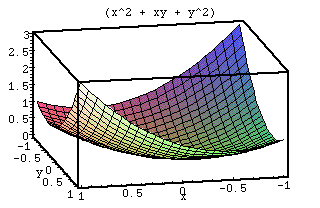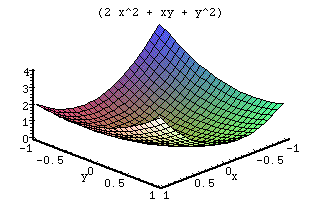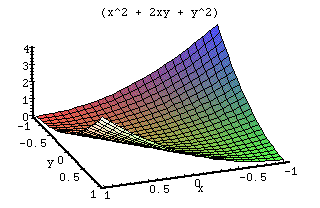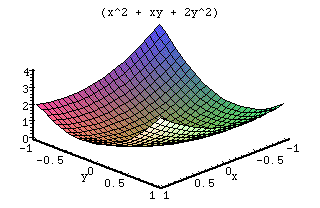Function
f(x,y) = px2 + qxy + ry2
Domain
x and y are elements of the set of all Real numbers
Graphs




Derivative
With respect to x: 2px + qy
With respect to y: qx + 2ryCritical points are formed where the two derivatives equal 0. These critical points may be minimums, maximums, or saddle points. In the first graph, for x2 + xy + y2, 0 = 2x + y which happens only when x and y are both 0. For y, 0 = x + 2y only when x and y are both 0. Therefore the only critical point is (0,0) which is the lowest point, 0.
Integral
With respect to x: ( 1/3 )px3 + ( 1/2 )px2y + ry2x + c
With respect to y: px2y + ( 1/2 )qxy2 + ( 1/3 )rq3 + c
Double Integral: ( 1/3 )px3y + ( 1/4 )qx2y2 + ( 1/3 )ry3x
Break down, first with respect to x: ( 1/3 )px3 + (1/2 )qx2y + ry2xThis is taken then with respect to y and the final double integral is returned. The double integral allows us to find the volume of an area under a surface and the xy plane. Looking at two examples, we want to find the area bound by x from -1 to 1 and y from -1 to 1 in the first graph. We first evaluate the first breakdown from -1 to 1. The second integral is then taken and evaluated from -1 to 1. For our first graph, the volume from x=-1..1 and y=-1..1 is ( 8/3 ). If we look at the volume from x=0..1 and y=0..1, the process is repeated, and the volume is ( 11/12 ).
Interesting Features
When working with this function, there are many different items to look at. The general formula forms a curved surface that gets the lowest at the origin (0,0). Since the values are squared, the negatives become positive and the curve appears symmetric. The p scales one end of the curve causing it to rise. The q value scales the values in a symmetric manner effecting x and y. The r functions exactly the same as p only on the other axis.
Back to top
Back to main page